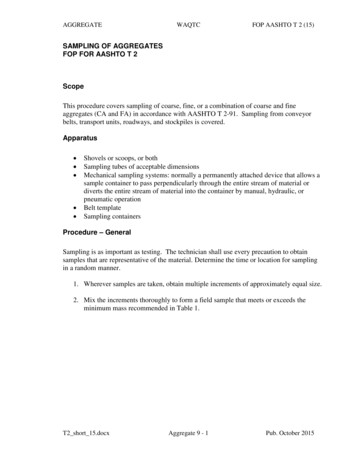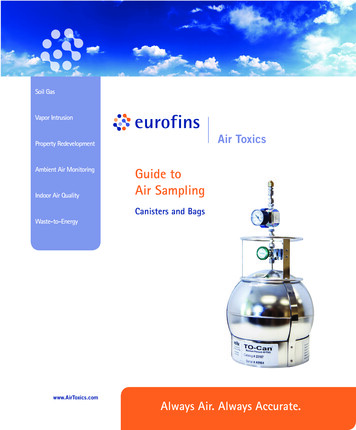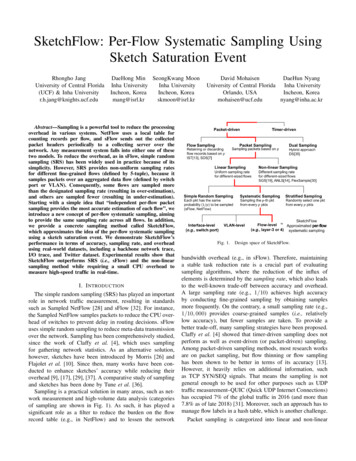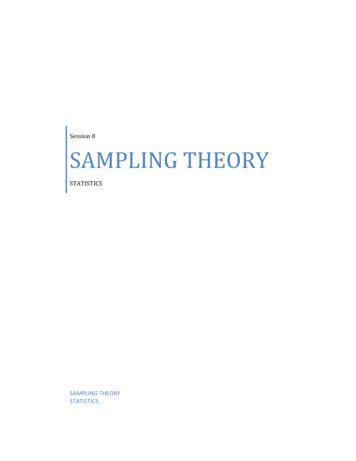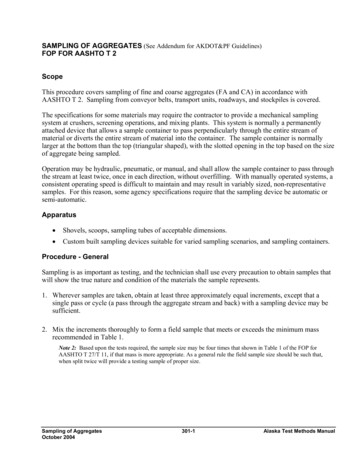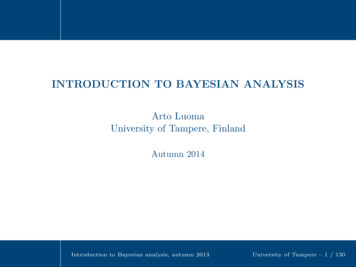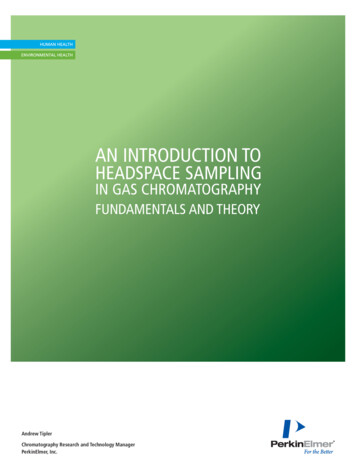
Transcription
AN INTRODUCTION TOHEADSPACE SAMPLINGIN GAS CHROMATOGRAPHYFUNDAMENTALS AND THEORYAndrew TiplerChromatography Research and Technology ManagerPerkinElmer, Inc.
An Introduction to Headspace Sampling in Gas ChromatographyTable of ContentsIntroduction3Fundamental Theory of Equilibrium Headspace Sampling3Volatile Analytes in a Complex Sample3Partition Coefficients4Phase Ratio5Vapor Pressures and Dalton’s Law6Raoult’s Law7Activity Coefficients7Henry’s law8Putting It All TogetherEffect of Sample Volume9Effect of Temperature10Effect of Pressure11Effect of Modifying the Sample Matrix12Effect of the Equilibration Time12Specialized HS Injection Techniques13The Total Vaporization Technique13The Full Evaporation Technique14Multiple Headspace Extraction15Transferring the Headspace Vapor to the GC Column17Injection Time and Volume17Manual Syringe Injection18Automated Gas Syringe Injection18Valve Loop Injection20Pressure Balanced Sampling20Direct Connection20Split Injector Interface22Split Injector Interface with Zero Dilution Liner (ZDL)23Improving Detection Limits2924Sample Stacking On Column24On-Column Cryofocusing25Dynamic Headspace Sampling26Headspace Trap Sampling27Solid Phase MicroExtraction (SPME)30Conclusion33References33Glossary34
An Introduction to Headspace Sampling in Gas ChromatographyIntroductionThis document is intended to provide the newcomer toheadspace sampling with a concise summary of the theory andprinciples of this exciting technique.If we put a sample of this perfume into a sealed vial and heat itto a moderate temperature (say 60 C) for a period of time, whathappens to the various molecules in the perfume inside the vial?Enough information is included here for the user to understandthe basic concepts and relationships in HS sampling to applyduring method development and interpretation of data.Although emphasis is given to the PerkinElmer TurboMatrix HSsystems, the document also covers alternative systems so that itshould be useful to all potential users of HS systems.Consider Figure 2. The more volatile compounds will tendto move into the gas phase (or headspace) above theperfume sample. The more volatile the compound, the moreconcentrated it will be in the headspace. Conversely, the lessvolatile (and more GC-unfriendly) components that represent thebulk of the sample will tend to remain in the liquid phase. Thusa fairly crude separation has been achieved.It is not intended to be a comprehensivereview of the subject and the reader isdirected to an excellent book on thissubject by Bruno Kolb and Leslie S.Ettre entitled “Static Headspace-GasChromatography”[1]. This book is availablefor purchase from PerkinElmer under thepart number: N101-1210.If we can extract some of the headspace vapor and inject itinto a gas chromatograph, there will far less of the less-volatilematerial entering the GC column making the chromatographyFundamental Theory of EquilibriumHeadspace SamplingVolatile Analytes in a Complex SampleHeadspace sampling is essentially a separation technique inwhich volatile material may be extracted from a heavier samplematrix and injected into a gas chromatograph for analysis.To appreciate the principle, let’s consider an application that iswell suited for headspace sampling: perfume. The compositionof perfume may be highly complex containing water, alcohol,essential oils etc. If we inject such a sample directly into a typicalGC injector and column, we get the chromatogram shownin Figure 1. A lot of time may be wasted in producing thischromatogram by eluting compounds that we have no interestin. Furthermore, many of these compounds may not be suited togas chromatography and will gradually contaminate the systemor even react with the stationary phase in the column so theirpresence is unwelcome.Figure 1. Chromatogram from direct injection of a perfume sample.Figure 2. Movement of perfume molecules within a sealed and heated vial.much cleaner, easier and faster. A headspace sampling systemautomates this process by extracting a small volume of theheadspace vapor from the vial and transferring it to the GCcolumn. Figure 3 shows a chromatogram produced from aheadspace sample taken from the same sample of perfume thatproduced Figure 1.Figure 3. Chromatography of a perfume sample with headspace sampling.www.perkinelmer.com3
An Introduction to Headspace Sampling in Gas ChromatographyPartition CoefficientsThe previous description is simplified. In practice, the migrationof compounds into the headspace phase does not just dependon their volatility but more on their affinity for the originalsample phase. Furthermore, if the contents inside the samplevial are left long enough, the relative concentrations of acompound between the two phases will reach a steady value(or equilibrium).For every compound, there is a thermodynamic energyassociated with its presence in the headspace phase and inthe liquid phase. These thermodynamic properties dictate howthe molecules will ultimately distribute themselves betweenthe two phases. The most convenient way of representing thisdistribution is through the partition coefficient (also known asthe distribution ratio), K.The partition coefficient is proportional to the ratio of theconcentration of molecules between the two phases when atequilibrium as shown in Equation 1.K CSCG.Equation 1Where:K is the partition coefficient of a given compound betweensample (liquid) phase and the gas (headspace) phaseCS is the concentration of that compound in the sample(liquid) phaseCG is the concentration of that compound in the gas(headspace) phaseNote that compounds with a high value for K will favor theliquid phase whereas compounds with a low K will favor theheadspace phase. As we want to analyze the headspace phase,we want to ensure that the values of K for the analytes aremuch lower than that of unwanted components in the samplematrix. The value of K will be dependent on both the compoundand the sample matrix and it will also be strongly affectedby temperature.Note that this relationship will only apply when the contents inthe sample vial are at equilibrium. Thus if this state is attained,then the analytical results should be precise and predictable.This leads to the more formal title for the technique of‘Equilibrium Headspace Sampling’ (sometimes also called‘Static Headspace Sampling’).It is possible to sample the system when not at equilibrium(and this may be necessary for some samples) but the analyticalprecision and detection limits may suffer.4Table 1 shows values of K for a range of compounds in waterair systems at 60 C [2, 3].Table 1: Partition coefficients of various compounds between water and airphases at 60 1o-Xylene1.31Isopropyl chloroethane1.47Methyl ethyl ketone68.8Tetrachloroethylene1.27Ethyl acetate29.3n-Hexane0.043n-Butyl acetate13.6Cyclohexane0.040Benzene2.27To further explain the meaning of K, let’s look at two extremesin Table 1: ethanol and cyclohexane. A value for K of 511for ethanol means that there is 511 times the volumetricconcentration of ethanol in the liquid than in the headspace.This is expected because of the significant hydrogen bondingbetween the alcohol and water hydroxyl groups. On the otherhand, cyclohexane, which does not exhibit any significanthydrogen bonding, has a K of 0.04 which means the oppositeis true; there is approx 25 (inverse of 0.04) times higherconcentration in the headspace. In summary, if K is less than 1then the analyte favors the headspace while if K greater than 1,the analyte favors the liquid phaseIn practice, this means that it should be easy to use headspacesampling to extract light hydrocarbons from water and moredifficult to extract alcohols from water – this provides thetheoretical justification to an observation that is ratherintuitive anyway.
An Introduction to Headspace Sampling in Gas ChromatographyPhase RatioOther factors that can affect the concentration of an analyte inthe headspace phase are the respective volumes of the sampleand the headspace in the sealed vial.The mass of compound in the original sample will be the sumof the masses in the two phases at equilibrium as shown inEquation 7.The concentration of analyte in the sample and the headspacecan be expressed respectively as Equations 2 and 3.M0 MS MG . Equation 7CS MSVS. Equation 2CG MGVG. Equation 3Where:CS is the concentration of compound in the sample(liquid) phaseCG is the concentration of compound in the gas(headspace) phaseMS is the mass of compound in the sample (liquid) phaseMG is the mass of compound in the gas (headspace) phaseVS is the volume of the sample (liquid) phaseVG is the volume of the gas (headspace) phaseWhen the vial contents are at equilibrium, Equations 2 and 3may be substituted into Equation 1 to give Equation 4.K MS VGMG VS.Equation 4The ratio of the two phase volumes may be expressed as thephase ratio as shown in Equation 5.β VGVSSubstituting Equation 5 into Equation 4 gives Equation 6.This equation shows us how the mass of a compound will bedistributed through the two phases if we know the phase ratioand the partition coefficient.MSMGThe three compound masses in Equation 7 may be related to thephase concentrations and volumes by Equations 8 to 10.M0 C0 VS . Equation 8MS CS VS . Equation 9MG CG VG. Equation 10Where:C0 is the concentration of compound in the original samplebefore analysisSubstituting Equations 8 to 10 into Equation 7 givesEquation 11.C0 VS CS VS CG VG . Equation 11The compound concentrations in each phase may be relatedto the partition coefficient by Equation 12, which is are-arrangment of Equation 1.CS K CG . Equation 12Where:β is the phase ratioK Where:M0 is the total mass of compound in the original samplebefore analysis β . .Equation 6Substituting Equation 12 into Equation 11 gives Equation 13C0 VS K CG VS CG VG .Equation 13Rearranging Equation 13 gives Equation 14.C0 CG [ KVSVS VGVS].Equation 14Equation 6 shows how the masses will be distributed but fora chromatographic analysis we need to find a relationshipthat will enable us to relate the GC detector response to theconcentration of a compound in the original sample.www.perkinelmer.com5
An Introduction to Headspace Sampling in Gas ChromatographyEquation 14 may be further manipulated to give Equation 15CG CO(K β). Equation 15Equation 15 is one of the key relationships in equilibriumheadspace sampling. It tells us the following: I f we increase the sample volume, VS , we will reducethe headspace volume, VG , in the same vial and so βwill be reduced as a result. Decreasing β will increase theconcentration of all compounds in the headspace phase. I f we decrease K, for instance by raising the vialtemperature, then this will have the effect of pushing morecompound into the headspace. Of course more of thesample matrix will also pass into the headspace and there isa risk of increasing the pressure inside the vial that affectsthe sampling process or even cause leakage or breakage inextreme cases. I f we keep K and β consistent between samples andcalibration mixtures, then the compound concentration inthe headspace vapor (and thus the chromatographic peakarea) will be directly proportional to its concentration in thesample prior to analysis. I t helps us predict the impact of changing K and/or β onthe observed chromatographic peak size.Vapor Pressures and Dalton’s LawSo far, in this discussion we have assumed that the value of K isconstant for a given compound. This should be the case if thetemperature and the sample matrix are consistent. While thisis true for dilute solutions, inter-molecular interactions maycause deviations at higher concentrations. To understand thisfurther we need to consider the relationship between K andvapor pressure.If we were to examine the composition of the headspacevapor from a complex liquid sample that has been sealed andthermally equilibrated inside a suitable vial, we would finda variety of compounds present. Each compound vapor willcontribute to the total pressure observed inside the vial. Dalton’sLaw of Partial Pressures states that the total pressure exerted bya gaseous mixture is equal to the sum of the partial pressures ofeach individual component in a gas mixture. At equilibrium, thepartial pressure of a compound will be equivalent to the vaporpressure of that compound. This relationship can be expressedas Equation 16.ptotal pi . Equation 16Where:ptotal is the total pressure of the headspace vaporpiis the partial pressure of component iThe partial pressure of each component in the headspaceis proportional to the fraction of its molecules in the totalmolecules present as shown in Equation 17.pi ptotal xG(i) . Equation 17Where:xG(i) is the mole fraction of compound i in the headspace vaporBecause the concentration of a compound in the headspacevapor is directly proportional to the number of molecules of itpresent, we can say that its concentration is proportional to itspartial pressure.6
An Introduction to Headspace Sampling in Gas ChromatographyRaoult’s LawIn a binary mixture, there are types of 3 molecular interactions:Raoult’s Law states that the vapor pressure of a compoundabove a solution is directly proportional to its mole fraction inthat solution as shown in Equation 18. Between molecule A and molecule A Between molecule B and molecule B Between molecule A and molecule Bpi pi0 xS(i) . Equation 18If the nature of these interactions is similar in all three instances,then the value of γi would be close to 1 and Equation 18and Figure 4 would apply. An example would a mixture ofcompounds with the same molecular structure but containingdifferent isotopes.Where:pi0 is the vapor pressure of the pure compound i in theheadspace vaporxS(i) is the mole fraction of compound i in the liquid phaseIn essence, Equation 18 tells us that the concentrationof a compound in the vapor phase is proportional to itsconcentration in the liquid phase.This relationship may be depicted graphically as shown inFigure 4. The compound concentration and the resultantGC peak area will be proportional to its vapor pressure.If the molecular attractions are stronger between differentmolecules than within the pure compounds, then the valueof Compound A would become and give rise to a partialpressure relationship as illustrated in Figure 5 in which hydrogenbonding is higher between dissimilar molecules in a mixture ofchloroform and acetone [4].TotalTotalCompound BCompound BCompound ACompound AFigure 4. Relationship between partial pressures and mole fractions in an idealbinary mixture.Activity CoefficientsEquation 18, however, assumes that the components in themixture behave in an ideal manner. In practice this rarely occursbecause molecules may interact with each other and have aconsequential effect on the vapor pressure. To accommodatethese deviations from the ideal, Raoult’s Law is modified toinclude activity coefficients as shown in Equation 19.Figure 5. Relationship between partial vapor pressures and mole fractions in amixture of chloroform and acetone with negative activity coefficients.So what does all this mean with respect to the value of thepartition coefficient, K?By combining Equation 17 with Equation 19, we can deriveEquation 20.K ptotalpi0 γi.Equation 20pi pi0 γi xS(i) .Equation 19Where:γi is the activity coefficient of the compound i in thesample mixturewww.perkinelmer.com7
An Introduction to Headspace Sampling in Gas ChromatographyIf the molecular attractions are weak between differentmolecules than within the pure compounds, then the valueof γi would become positive and give rise to a partial pressurerelationship as illustrated in Figure 6 for a mixture of n-hexaneand ethanol [4].TotalCompound ACompound BFigure 6. Relationship between partial pressures and mole fractions in amixture of n-hexane and ethanol with positive activity coefficients.Henry’s LawNote that the value of γi may change with concentration. Ina dilute solution with concentrations less than approximately0.1%, the molecular interactions for a compound will be almostexclusively with other molecules in the sample matrix andnot with those of itself. This has the effect of making γi andhence K effectively constant over a range of applied conditions.Under these conditions, Henry’s Law will apply. This statesthat, at a constant temperature, the amount of a gas dissolvedin a liquid is directly proportional to the partial pressure ofthat gas at equilibrium with that liquid. This can be expressedmathematically by Equation 21.8pi Hi xS(i) . Equation 21Where:pi is the is the Henry’s Law constant for compound i in thesample matrixNote that although Equation 21 looks very similar toEquation 18 and Equation 19, it will only be equivalentif the activity coefficient is unity. In all other instances,Equation 21 will only apply at the extremes of the chartsshown in Figure 5 and Figure 6.Because analysis involving headspace sampling and gaschromatography is normally looking at analyte concentrationswell below 0.1%, in the vast majority of applications,Henry’s Law will apply and we can assume that K will beconstant across the range of concentrations to be monitoredand thus that the concentration in the headspace will beproportional to the original concentration in the sample.At higher concentrations, some non-linearity in the responsecurve is to be expected because the activity coefficients will varyand so the analysis will require a multi-level calibration withcurve fitting for accurate quantification.
An Introduction to Headspace Sampling in Gas ChromatographyPutting It All TogetherSo what do all these equations mean to the chromatographer?In the following discussion, we will assume that we are dealingwith the analysis of components at low concentrations and so Kwill not change with different concentrations.Effect of Sample VolumeEquation 15 shows us that the concentration of a compoundin the headspace vapor phase is proportional to its originalconcentration in the sample and the reciprocal of the partitioncoefficient K added to the phase ratio β. If K is low (thecompound prefers the headspace phase), then the value of β(hence sample volume), significantly affects the concentrationin the headspace phase. Conversely if K is high (the compoundfavors the sample phase) then adjusting β will have a minoreffect on the concentration in the headspace phase.Figure 7. Headspace concentration versus sample volume for ethanol in waterat 60 C (K 511) in a 22 mL vial.The effect of adjusting the sample volume in a typical vial onconcentration in the headspace phase for three compoundswith high, medium and low partition coefficients is illustratedgraphically in Figure 7, Figure 8 and Figure 9 respectively (notethe different scaling of the y-axes for each of these).In the case of a compound with a high partition coefficient suchas ethanol in water as shown in Figure 7 the effect of changingthe sample volume makes little difference to the concentrationin the headspace vapor. In instances where sample is in shortsupply (e.g. forensic samples), lower volumes may be usedwith no significant loss in performance. Note that although theconcentration and GC response will be largely independent ofthe sample volume, there will still be proportionality betweenthe sample concentration and the concentration in theheadspace vapor.In situations with a medium value for K as seen for toluenein water as shown in Figure 8, there is an approximatelyproportional relationship between sample volume andheadspace concentration.Figure 8. Headspace concentration versus sample volume for toluene in waterat 60 C (K 1.77) in a 22 mL vial.With a very low value for K as shown for n-hexane in Figure 9,a small change in the sample volume makes a big difference inheadspace concentration. In these instances, analytical detectionlimits are greatly enhanced by an increase in sample volume.Note that is it even possible to create a headspace with a higherconcentration of the compound than originally in the sample.Figure 9. Headspace concentration versus sample volume for n-hexane inwater at 60 C (K 0.043) in a 22 mL vial.www.perkinelmer.com9
An Introduction to Headspace Sampling in Gas ChromatographyEffect of TemperatureThe partition coefficient of a compound in the sample isrelated to the inverse its vapor pressure when pure as shownin Equation 20. Vapor pressure increases with temperature andso the value of K will decrease and more of the compound willpass into the headspace phase. This observation is very intuitive– hot liquids will quickly release dissolved volatile compounds.Table 2 is an extension to Table 1 showing partition coefficientsover a range of temperatures.Table 2. Partition coefficients of various compounds between water and airphases over a range of temperatures [2, 3].Compound40 C60 C70 C80 CDioxane1618642412288Ethanol1355511328216Isopropyl alcohol825286179117n-Butanol64723814999Methyl ethyl ketone139.568.847.735.0Ethyl acetate62.429.321.817.5n-Butyl igure 10. Headspace concentration versus temperature for ethanol in water.Figure 11. Headspace concentration versus temperature for toluene in water.Data from Table 2 for ethanol, toluene and n-hexane are plottedgraphically in Figure 10, Figure 11 and Figure 12 respectively(note the different scaling of the y-axis in each of these).From Figure 10 we see that the headspace concentration ishighly affected by a change in temperature for a compoundlike ethanol with high values of K when in water. This chartunderlines the need for careful temperature control of the vialduring the equilibration step. For instance if the temperature ofthe vial drifted by only 1 C from a set temperature of 60 C,the change in concentration of ethanol in the headspace wouldchange by almost 5%. To achieve a quantitative precision of0.5% (which is typical for a good headspace sampling system)the temperature of the vial must be controlled to within 0.1 C.For medium values of K, the relationship is approximatelyproportional as shown in Figure 11.When K is low, there is only minor change in the headspaceconcentration as the temperature is raised as shown in Figure 12.10Figure 12. Headspace concentration versus temperature for n-hexane in water.
An Introduction to Headspace Sampling in Gas ChromatographyEffect of PressureOne important aspect that must be considered when changingtemperature is the effect on the vapor pressure of the samplematrix. In the case of water, which is present in most samplematrices, the vapor pressure increases with temperature asshown in Figure 13.Equation 17 shows us that the concentration of a compound inthe headspace phase is proportional to its partial pressure in theheadspace phase.To establish the partial pressure, we must first determine whatthe total pressure of the headspace vapor will be.The pressure inside a sealed sample vial will increase throughone of two reasons: Its temperature is increased. This will increase the vaporpressure of any liquids in the sample and will increase thepressure of the air inside the vial when it was sealed. Carrier gas is added for sampling purposes. On some systems,including those that use the PerkinElmer pressure-balancedsampling technique, carrier gas is used to pressurize thesample vial to an elevated pressure immediately prior tosampling. Thus the headspace vapor contains vapors from thesample, air that was present inside the vial when it was sealedand an amount of carrier gas necessary to attain a pressureinside the vial required for sampling purposes.Figure 13. Vapor pressure of water versus temperature [5].As stated at the beginning of this document, headspacesampling is essentially a separation technique in which we try toextract and inject the volatile components and leave the bulk ofthe less-volatile sample matrix in the sample vial.For nearly all compounds, the concentration ratio of acompound in water to that in the headspace vapor will increaseproportionally as the sample temperature is increased. Thisrelative increase is most pronounced with compounds with alow value of K.Thus although increasing temperature can be a very effectiveway of increasing analyte concentration in the headspacevapor, especially for compounds with a high value of K, therewill still be a significant increase in the amount of water vaporin the headspace vapor. If a column or detector is particularlysusceptible to the presence of water then caution must beexercised before increasing the temperature significantly.Also note that a heated liquid inside a sealed vial can build up asignificant vapor pressure which could easily exceed the pressurerating of a sample vial, so check the vial specifications carefullybefore proceeding.For the purposes of this discussion, we will focus on the secondreason as this is what will be occurring on the PerkinElmerheadspace sampling systems.When carrier gas is injected into the sample vial to raise thepressure, the partial pressure of the compound vapor doesnot change; neither does the volume of the headspace vapor.Thus although the compound concentration decreases whenexpressed in terms of a mole fraction, the concentration whenexpressed as weight/volume remains the same. We typicallyexpress concentrations in headspace sampling as ppm w/v orppb w/v and so, if we think in these terms, the act of injectingcarrier gas into the vial has no effect on the concentration ofanalyte vapors in the headspace phase.Once the headspace vapor is withdrawn from the vial, it willdecrease in pressure as it passes down the transfer line and thecolumn. This expansion will effectively cause a dilution whenthe concentration is expressed in terms of weight/volume and,depending on the injection technique, may affect the amount ofa compound injected into the column and detector. This effectwill be more significant with higher vial pressures.Over-pressurizing can also lead to premature injection ofthe headspace vapor giving it a double peak effect in thechromatography.www.perkinelmer.com11
An Introduction to Headspace Sampling in Gas ChromatographyEffect of Modifying the Sample MatrixEffect of the Equilibration TimeThe activity coefficients discussed in Equation 19 may beadjusted in many cases by the addition of salts or solvents tothe sample matrix. These modifiers are chosen to increase theactivity coefficients and so decrease the partition coefficients andcause more of the compound to pass into the headspace phase.One other factor that should be considered at this point isthe equilibration time. The preceding discussion talks aboutthe partition coefficient and its role in dictating the finalcompound concentration in the headspace phase for a givenset of applied conditions.Table 3 shows the potential benefit of adding inorganic saltsto water samples that are to be analyzed for ethanol content.The presence of these salts changes the nature of the molecularinteractions; there is now far more ionic activity. This causes anincrease in the activity coefficient of ethanol with a resultantincrease in the concentration of it in the headspace phase.Partitioning is a process that takes a finite time to complete.Molecules need to move around within the sample phase andheadspace phase and between the two. The two most timeconsuming factors are the molecular diffusion within the liquidsample phase and the mass transfer across the phase boundary.Table 3. Potential increase in the concentration of ethanol in the headspacephase after adding salt modifiers to water samples.SaltIncrease in ConcentrationAmmonium sulfatex5Sodium chloridex3Potassium carbonatex8Ammonium chloridex2Sodium citratex5Table 4 shows the results of an experiment to investigatethe effect of adding water to solutions of various analytes indimethylformamide (DMF). This is an important applicationfor headspace sampling as it enables residual solvents to bemonitored in pharmaceutical preparations.It is difficult to model this kinetic behavior mathematically andso in most instances, experiments need to be performed toestablish the necessary equilibration time. This normally involvesthe analysis of a series of identical mixtures with known amountsof added analyte(s). The analytical conditions are the same foreach analysis except that the equilibration time is incrementedbetween successive runs. At the end of this sequence, a plotof peak response versus equilibration time for each analyte iscreated and the point beyond which the response no longerincreases is established. This is illustrated in Figure 14. In thisexample, as the thermostatt
The mass of compound in the original sample will be the sum of the masses in the two phases at equilibrium as shown in Equation 7. Where: C S is the concentration of compound in the sample (liquid) phase C G is the concentration of compound in the gas (headspace) phase M S is the mass of compound in the sample (liquid) phase M G


